
Honda CR-V Review

Introduction
If you’ve got a young family, the latest crop of SUVs may well have caught your eye. The blend of easy access, space and relative affordability is a recipe that lots of leasing customers have been tempted by, and there’s plenty of choice on the market.
This is Honda’s offering, the CR-V, and the Japanese manufacturer hopes that its all-hybrid line-up, and the promise of resultant fuel savings, plus less tax for company car drivers, will temp you away from rivals that include the Toyota RAV4, Citroen C5 Aircross, Kia Sorento and plenty more.
Select's rating score* - 3.4 / 5
At a Glance
The CR-V has been part of Honda’s line-up for some time now, having been first introduced in the early days of the SUV revolution back in 1995. The model you’re looking at here was launched in 2018, and is the fifth generation.
Honda gave it a complete overhaul, upping the number of features and general feeling of luxury in order to compete with the ever-growing competition. It also dispensed with diesel engines, opting instead to offer a single petrol-electric full hybrid engine.

The company feels this offers the best balance of cost and fuel efficiency, without bumping up the cost in the way that some plug-in hybrid cars can do. There’s more space inside than ever before, and it’s designed to be a comfortable ride, rather than anything sporty.
You can pick from an impressive five different trim levels, and opt for front-wheel drive or four-wheel drive.
Key Features
Practicality and efficiency are the Honda CR-V’s key selling points. You also get plenty of choice of trim levels, and a very decent level of features across the board. You can, if you want, opt for the relatively spartan entry-level S model, but even then you’ll get plenty of standard safety features, which is very attractive on a car aimed at families.
Keyless entry and start, air conditioning, Bluetooth and a DAB radio are all standard, as are big alloy wheels, and higher trim levels get a touchscreen infotainment system.
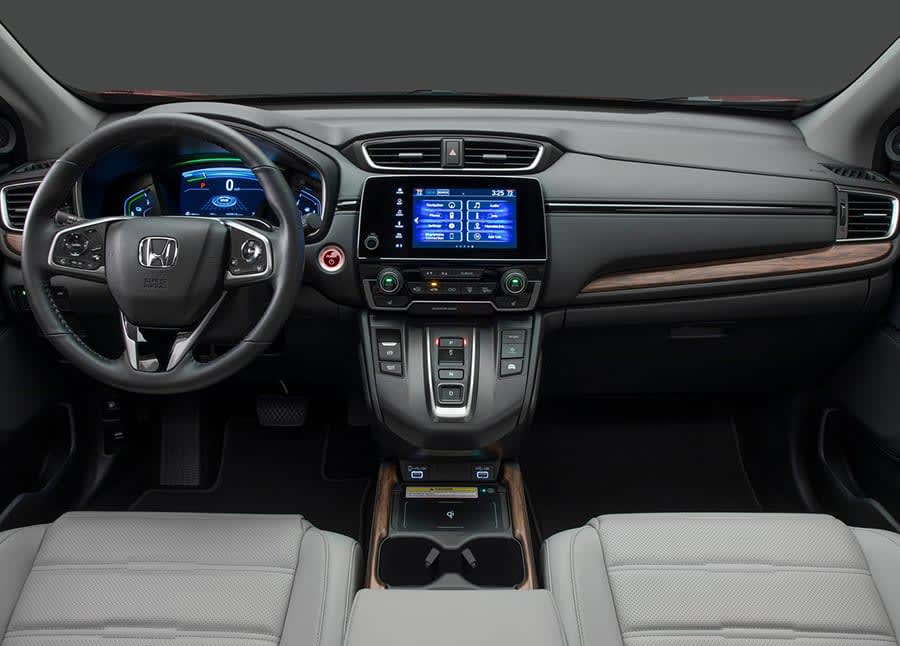
You’ll easily get five people into it, although there’s no longer the option of seven seats; earlier versions of the CR-V had a folding third row of seats at the back, but since Honda decided to go hybrid-only, the space needed for the extra chairs is taken up by batteries. That means you get a very spacious boot with great access; perfect for loading in the myriad small child accessories that parents need.
Performance & Drive
While earlier versions of the CR-V were available with a range of different engines, Honda has since slimmed things down, and offers only a petrol-electric, full-hybrid powertrain. This combines a 2.0-litre engine with a pair of electric motors and a small battery. This harvests and stores kinetic energy from braking and while cruising, and can redeploy it to aid acceleration or to run for small distances on electric power only. It’s not a plug-in hybrid, which has a battery that you can recharge from the mains. These have much longer electric-only ranges – more than 30 miles – and can make huge fuel savings, but they’re generally more expensive to lease.
The hybrid system in the CR-V works well, with the electric-only system cutting in seamlessly when it senses the chance to save a bit of fuel. It works best around town, and if you do mostly urban driving you’ll see your MPG creeping up. At higher speeds it’s less effective though.
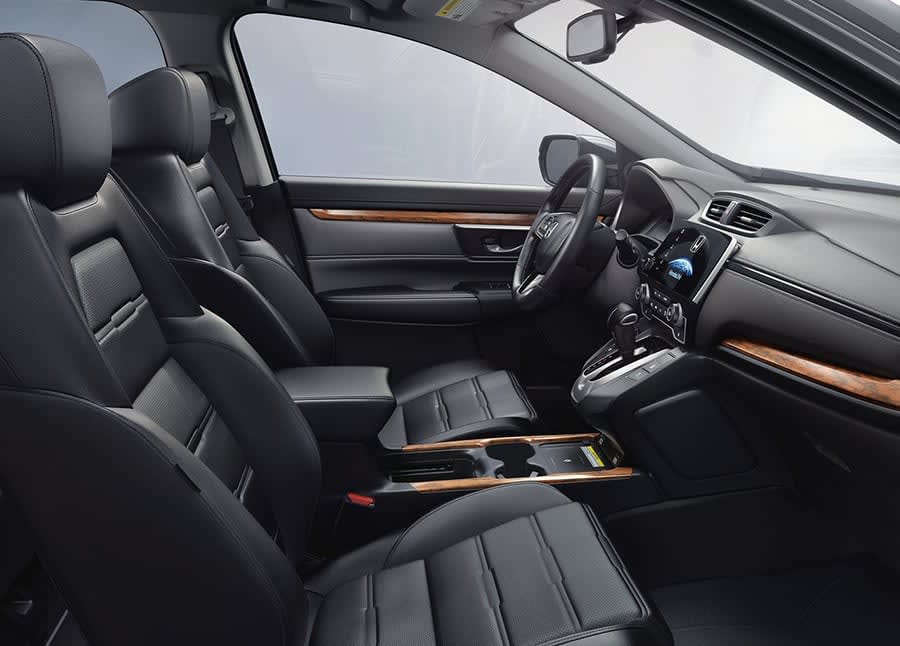
Acceleration is decent, with 181bhp of combined power to call upon. All models have what is, as far as most customers will be concerned, an automatic gearbox, although it’s an unusual system called iMMD that isn’t actually a gearbox. We’ll skip the technical explanation, but it generally works very well. Having said that, if you put your foot down hard the engine revs climb high and stay there, which can be disconcerting. It also sounds like someone’s started a strimmer outside your window.
There’s a choice of front-wheel drive or all-wheel drive. The latter may be better if you need to drive down the occasional muddy track, or live in an area of inclement weather, but this is no off-roader. Performance is down slightly in the AWD model, due to the extra weight.
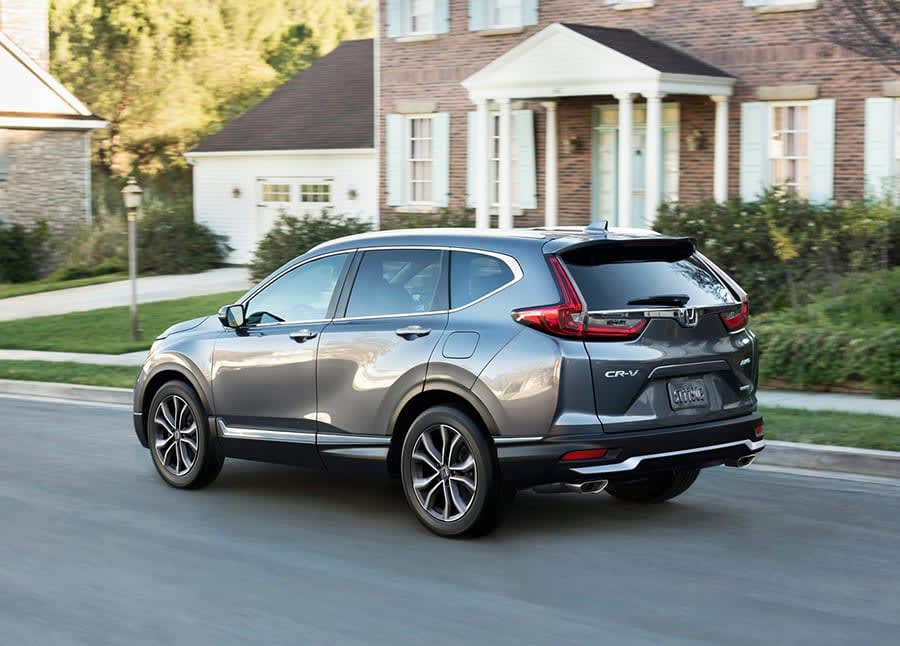
The CR-V’s handling and ride are very much geared towards comfort rather than sportiness (despite the presence of a Sport button on the dashboard). The ride quality is good, which passengers will thank you for; bad road surfaces are smoothed out nicely. The CR-V won’t be too happy if you try and hustle it down a country road though; there’s quite a bit of body roll, and it’s much better to keep things relaxed and just cruise to your destination.
It’s worth noting that if you’re looking for an SUV to use as a tow car, the CR-V probably isn’t the best choice; the hybrid powertrain is rated for a maximum towing weight of 750kg, which isn’t much. You can get more than double that from Ford’s Kuga hybrid.
Running costs & Emissions
Leasing costs on the CR-V are fairly reasonable for a car of this size, but you can pick up a Toyota RAV4 hybrid for considerably less each month, which is worth noting. Several non-hybrid options are also vying for your business at a lower price, including the excellent Skoda Kodiaq.
The CR-V’s hybrid powertrain is a big selling point because of its efficiency, at least on paper. We’ve found that you’ll get the best results using the CR-V around town, where regular stopping and starting keeps the battery topped up and means it can use more electric oomph rather than drinking petrol. It’s less effective at motorway speeds. Officially, the CR-V will give you 42.8mpg in front-wheel-drive models and up to 39.8mpg on all-wheel-drive models. You can potentially get far better results from rivals with plug-in hybrid systems, but they’ll generally cost more to lease.
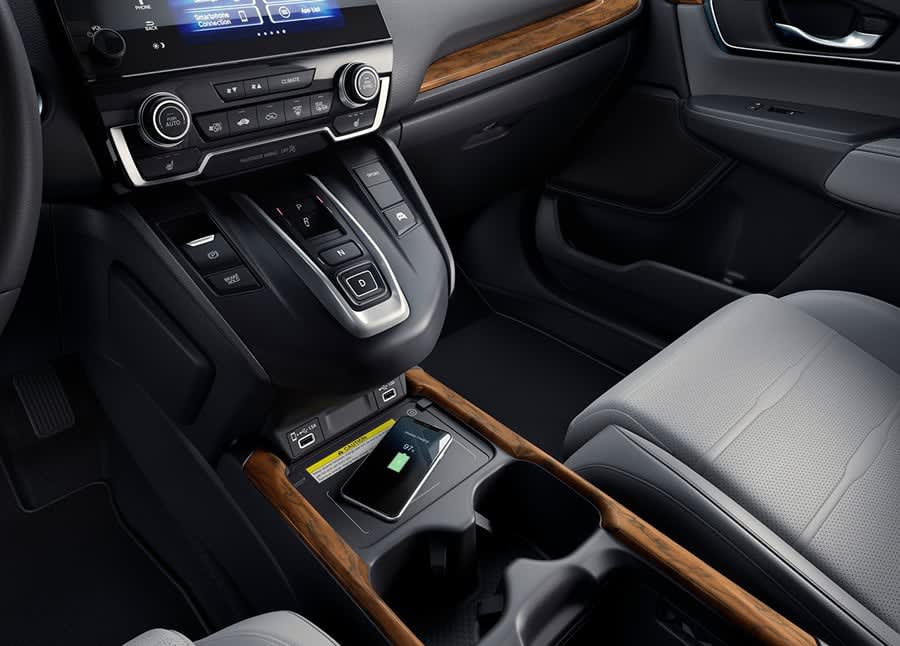
Emissions, depending on model and whether it’s two-wheel drive or all-wheel drive, are around 151g/km or 161g/km. Because regular hybrids don’t get any special treatment when it comes to benefit-in-kind company car tax, you’ll pay the same as you would for a regular petrol or diesel. That means that for 2020/21, you’ll be looking at tax brackets between 34% and 36%. Once again, plug-in hybrid cars will be considerably cheaper, as well as full electric models.
Interior & Technology
The CR-V’s interior feels like it was made for practicality and ease of use, which is a great priority for a family car. This comes at the slight expense of any real premium feel; all the materials feel less plush or classy as those in some rivals. Some plastics can be a bit hard and scratchy, but overall it’s entirely acceptable. The design isn’t fancy, but it’s easy to look at and use, with plenty of thought for practicality; more on that in the next section.
Most models get a touchscreen in the centre of the dashboard, which is smaller and less sophisticated than those of most rivals; it feels a bit old fashioned in comparison, and isn’t particularly fast to respond. It does have Apple CarPlay and Android Auto though, so we’d recommend ignoring Honda’s own features and just plugging your smartphone in. There are plenty of physical controls for ancillary systems like air conditioning though, which means no delving through menus just to turn the temperature up. That’s a plus in our book.
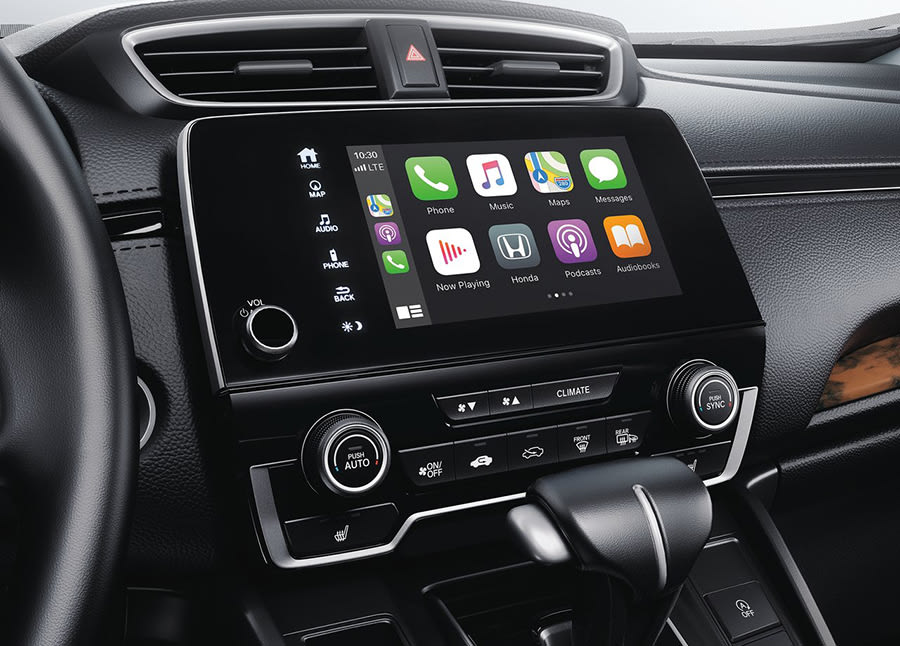
Behind the steering wheel is a digital instrument display, although it’s not as configurable as comparable systems, so you can’t really choose which information you want to show. Most of the basics are all covered though, and it looks pleasant enough.
Practicality & Boot Space
As long as you don’t need to carry seven people, space in the CR-V is excellent. There aren’t many cars that will give you as much passenger space, both front and back. You’ll easily get three adults in the back seats (yes, even in the middle) with plenty of legroom and headroom, and the back doors open extra-wide, which really helps with loading in children.
The good news continues in the boot. It was a reasonable size even when it had two extra seats in it, so with those removed it’s one of the biggest in the segment. It’s also a good shape, with a minimal lip at the entrance, which makes it easier to lug larger items in. It’;s a shame that the rear seats only fold down in a 60/40 split though; some rivals fold in a 40/20/40 split, which gives you more versatility for longer items and rear seat passengers.
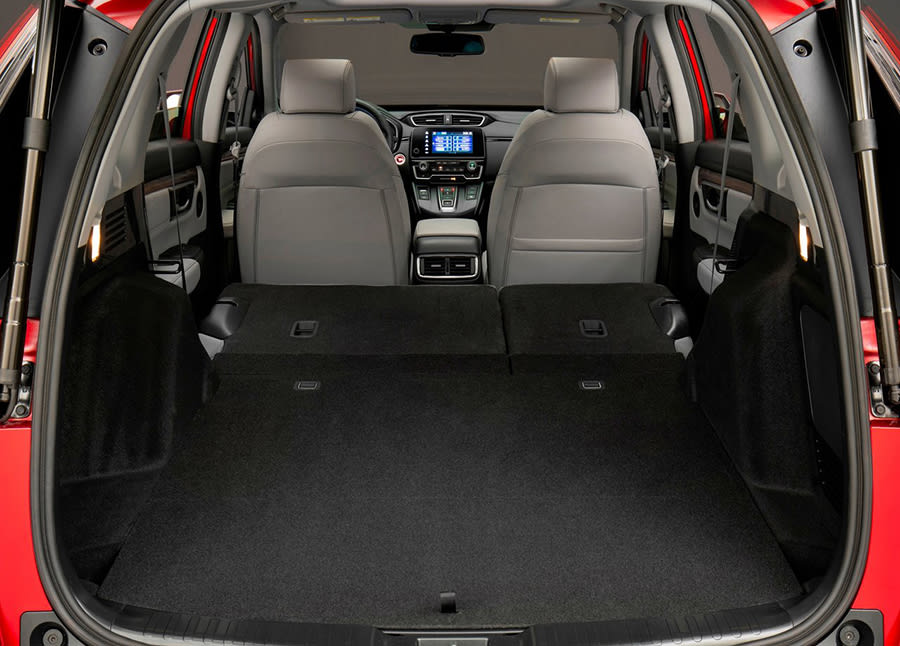
General storage is also very reasonable, with a huge space under the centre armrest, a couple of cup holders and a storage space in front of them between the front seats, which in higher-end models doubles as a wireless charging pad. The door pockets and glovebox aren’t that large, however.
Safety
The CR-V was tested by independent safety organisation Euro NCAP in 2019, and was awarded the maximum five-star score. All models come well equipped with some of the latest safety features, including automatic emergency braking, lane-keep assist and a traffic sign recognition system. You’ll also get front, side and curtain airbags and Isofix child seat mounting points on the outer rear seats. Higher-spec models also get a blind-spot warning system.
Options
There are an impressive five trim levels to choose from on the CR-V. The entry-level S model is only available in front-wheel drive and, while it features the basics, it’s missing quite a lot of the equipment that many modern customers would want. There’s no touchscreen infotainment system or Apple CarPlay/Android Auto, for example. But it does ride on 18-inch alloy wheels and features LED headlights and air conditioning, so it’s not exactly bare bones.
Most customers, however, will want to start their search with the SE model. This gets the infotainment system, dual-zone air conditioning and tinted rear windows, as well as a rear-view camera and mirrors that tilt down when you’re reversing to help you spot kerbs. There are parking sensors both front and rear, too.
Move up to the SR model and you’ll find leather upholstery and the blind-spot warning system, as well as heated front seats.

The Sport Line trim is only available on front-wheel drive models, and features leather seats and black alloy wheels, but if you want the fully loaded model you’ll need to go for the all-wheel-drive-only EX model. This adds in a heated steering wheel and heated rear seats, as well as a panoramic sunroof, electric boot lid and a head up display, which projects driving information onto a small screen on top of the dashboard. The wireless phone charger is included too.
Options include a series of styling packs, such as the Aero Pack, which adds a more aerodynamic look to the outside through different bumpers and a spoiler. The Style Pack is a more subtle addition to the exterior through some colour-coding, while the Premium Pack adds exterior trim, different carpets and front and rear mud guards. You can also choose from a variety of paint colours.
Rival Cars
The CR-V has a wide range of potential rivals, and its full-hybrid powertrain means it could be considered alongside regular petrol or diesel models, as well as plug-in hybrid competition. Other full hybrid models to consider include the Toyota RAV4, Ford Kuga and Hyundai Tucson, all of which are also available as a plug-in hybrid.
Of the non-hybrid options, we’d point you towards the Peugeot 3008 and Seat Ateca, while other PHEV possibilities include the Kia Sorento, Citroen C5 Aircross.
The lack of a seven-seat option in the latest CR-V means that if you need to carry more than five, you’ll have to look at cars like the Peugeot 5008, Land Rover Discovery Sport and Volkswagen Tiguan Allspace, as well as the Skoda Kodiaq and Seat Tarraco.
Verdict & Next Steps
The CR-V has much to recommend about it. It’s one of the most spacious cars of this type on sale, and there’s a wide choice of trims to choose from. The hybrid powertrain means fuel costs should be kept low, especially if you drive mostly around town. There are some aspects that require consideration though: the Honda is far from the cheapest car of this type to lease, even against other hybrids. The lack of engine choice could put people off too, and there’s no plug-in hybrid model, which rivals can boast and which could dramatically reduce running costs. The CR-V is definitely a car to check out and it’s very good at what it does, but it is competing against a lot of other very good, and keenly priced cars.
Where to next?
View latest Honda CR-V leasing deals - from just £320.63 per month inc VAT**
Looking for a great leasing deal? Check out our incredible range of car lease deals
New SUV? Read our latest Car Reviews and find the right model for you
Want to know more about leasing? Take a look at our comprehensive Leasing Guides
Interested in everything motoring? Why not catch up on all the latest Car Leasing News.
**Score based on Select’s unique meta score analysis, taking into account the UK’s top five leading independent car website reviews of the Honda CR-V
**Correct as of 15/10/2021. Based on 9 months initial payment, 5,000 miles over a 48 month lease. Initial payment equivalent to 9 monthly payments or £2885.67 Ts and Cs apply. Credit is subject to status.





















